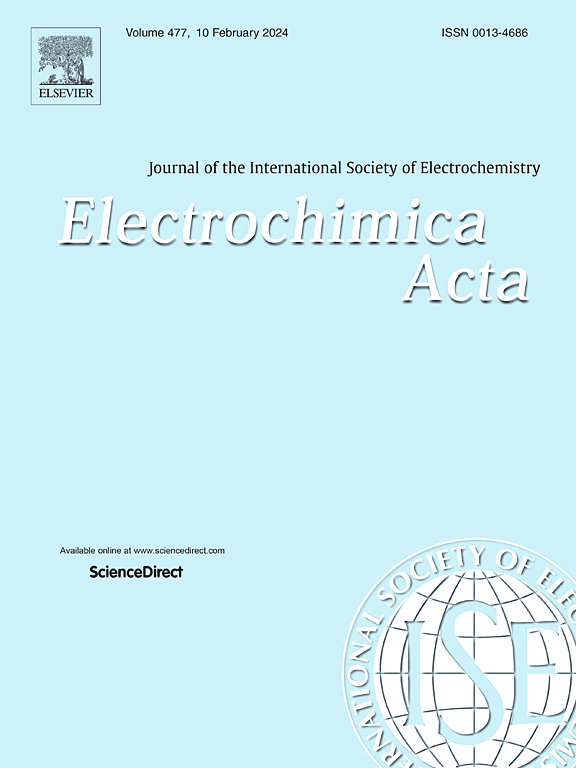Anodic electrochemical process in NaCl-KCl-Al2S3 molten salts
IF 5.6
3区 材料科学
Q1 ELECTROCHEMISTRY
引用次数: 0
Abstract
Al2S3 electrolysis process in NaCl-KCl molten salts is advantageous for aluminum production due to the low electrolysis temperature, reduced energy consumption, and no greenhouse gas emissions. It is S2- discharging on the anode and gaseous sulfurs is generated. However, the origin of S2- from either free S2- or S2- in complex ions has rarely been investigated, and the anodic electrochemical mechanism remains unclear. Herein, the discharge sequence of sulfur ions at a graphite anode in equimolar NaCl-KCl molten salts containing 1 wt.% Al2S3 electrolyte at 953 K was investigated by quantum chemical calculations, and the electrochemical mechanism was verified by linear sweep voltammetry, square wave voltammetry, and chronoamperometry. The results indicate oxidation of free S2- and S2- in AlSCl32- to produce gaseous sulfurs at the anode, with free S2- more prone to oxidation than S2- in AlSCl32- during the anodic electrochemical reaction. The oxidation reactions of both free S2- and S2- in AlSCl32- follow one-step two-electron transfer processes. Free S2- follows a quasi-reversible process, controlled by diffusion, with a charge transfer coefficient of 0.667 and a diffusion coefficient of 3.248 × 10-5 cm2·s-1. By comparison, S2- in AlSCl32- follows an irreversible process, controlled by diffusion, with a charge transfer coefficient of 0.561 and a diffusion coefficient of 1.351 × 10-5 cm2·s-1. Overall, these theoretical findings look very promising for future studies and the development of green electrolytic aluminum production processes using NaCl-KCl-Al2S3 molten salts.

NaCl-KCl-Al2S3熔盐的阳极电化学过程
在NaCl-KCl熔盐中电解Al2S3工艺具有电解温度低、能耗低、无温室气体排放等优点。在阳极上进行S2放电,产生气态硫。然而,从络合离子中游离的S2-或S2-中生成S2-的研究很少,其阳极电化学机制也不清楚。本文采用量子化学计算方法研究了硫离子在含1 wt.% Al2S3电解质的等摩尔NaCl-KCl熔盐中在953 K时在石墨阳极上的放电顺序,并通过线性扫描伏安法、方波伏安法和计时伏安法验证了其电化学机理。结果表明,AlSCl32-中游离的S2-和S2-在阳极处氧化生成气态硫,其中游离的S2-在阳极电化学反应中比S2-更容易被氧化。游离S2-和S2-在AlSCl32-中的氧化反应都遵循一步双电子转移过程。自由态S2-遵循准可逆过程,受扩散控制,电荷传递系数为0.667,扩散系数为3.248 × 10-5 cm2·s-1。而AlSCl32-中的S2-则是由扩散控制的不可逆过程,其电荷传递系数为0.561,扩散系数为1.351 × 10-5 cm2·s-1。总的来说,这些理论发现对未来的研究和使用NaCl-KCl-Al2S3熔盐的绿色电解铝生产工艺的发展非常有希望。
本文章由计算机程序翻译,如有差异,请以英文原文为准。
求助全文
约1分钟内获得全文
求助全文
来源期刊

Electrochimica Acta
工程技术-电化学
CiteScore
11.30
自引率
6.10%
发文量
1634
审稿时长
41 days
期刊介绍:
Electrochimica Acta is an international journal. It is intended for the publication of both original work and reviews in the field of electrochemistry. Electrochemistry should be interpreted to mean any of the research fields covered by the Divisions of the International Society of Electrochemistry listed below, as well as emerging scientific domains covered by ISE New Topics Committee.
 求助内容:
求助内容: 应助结果提醒方式:
应助结果提醒方式:


